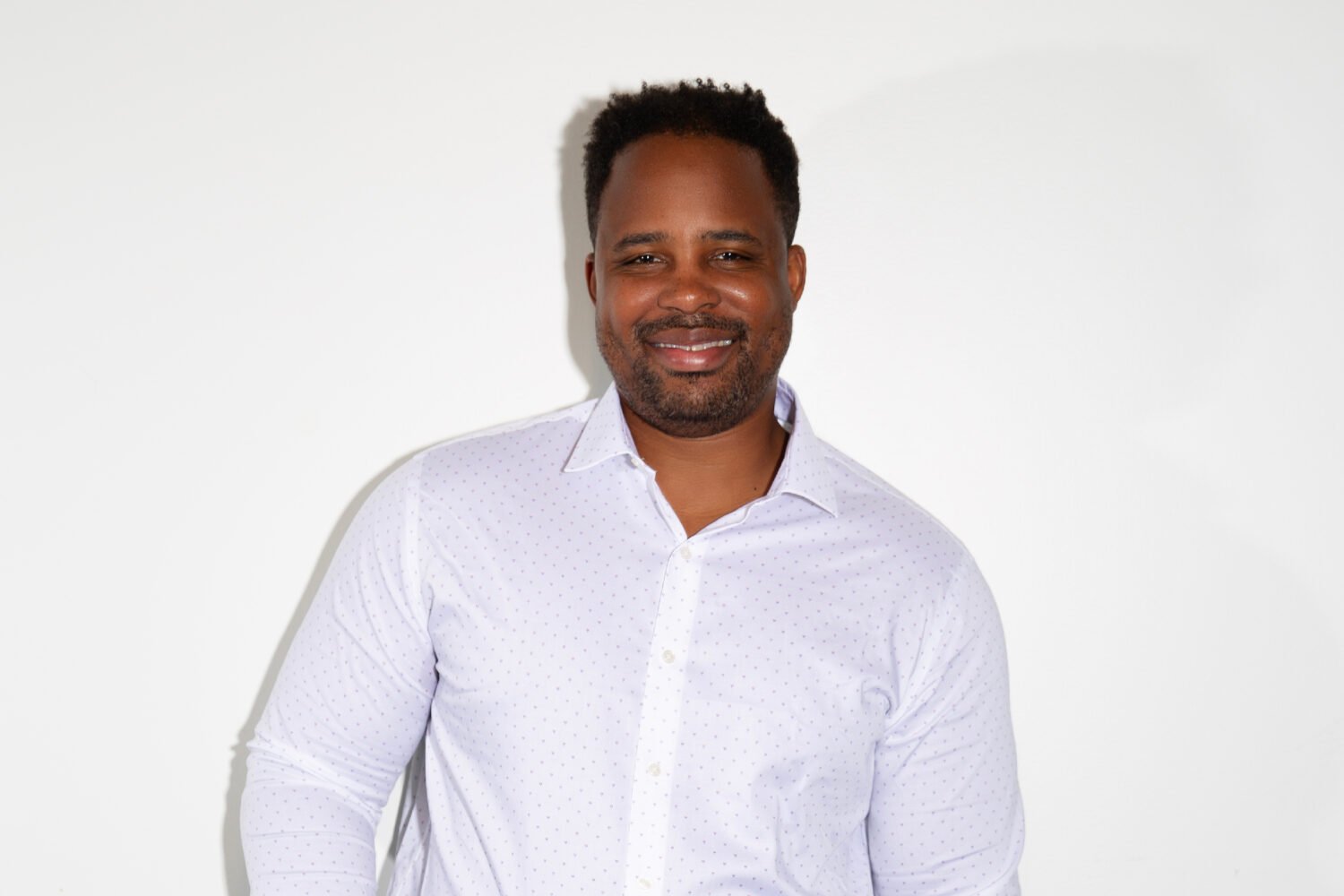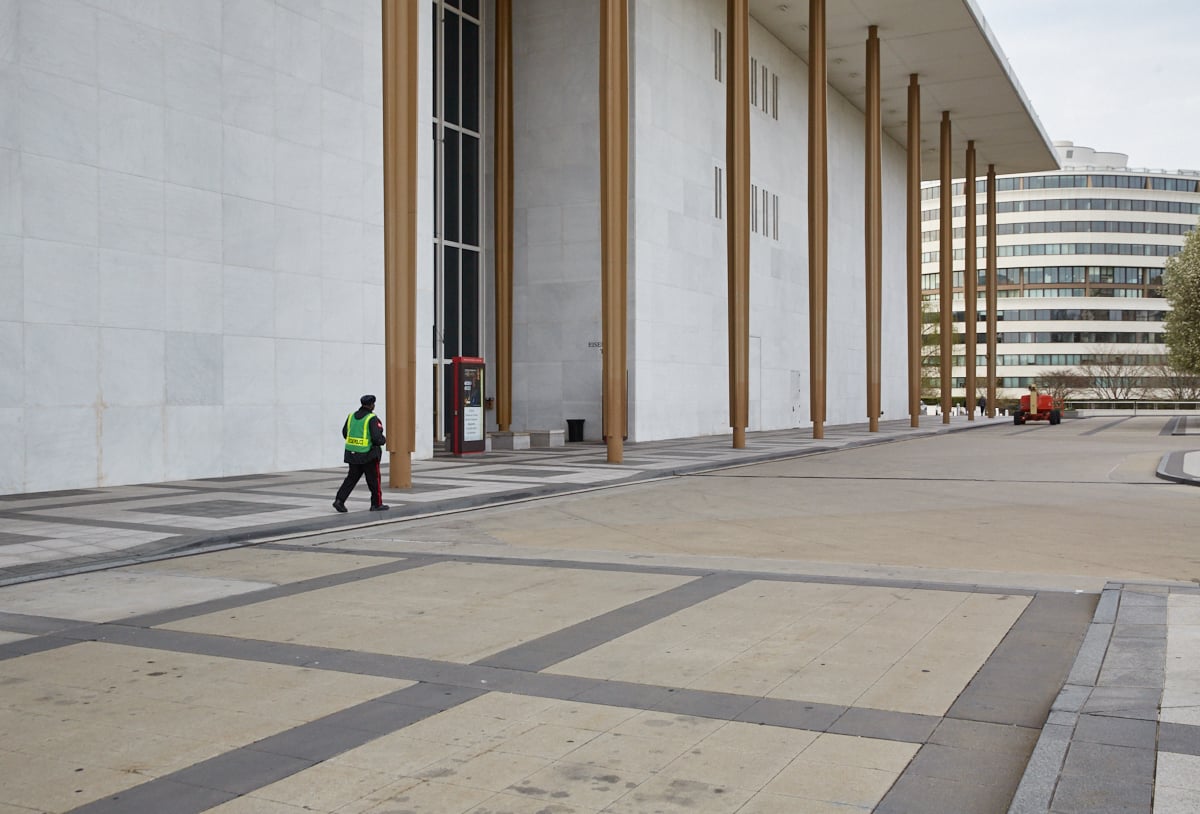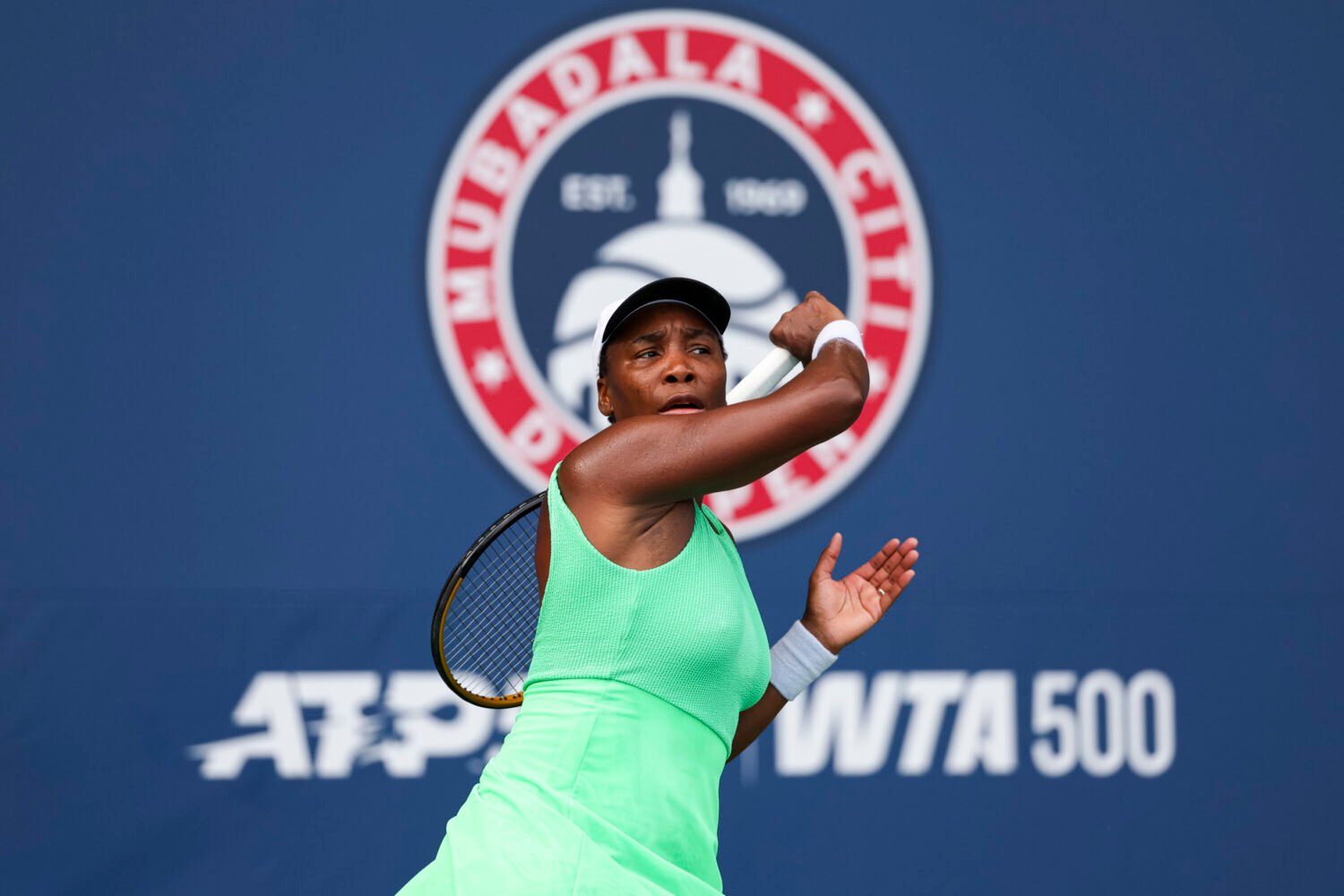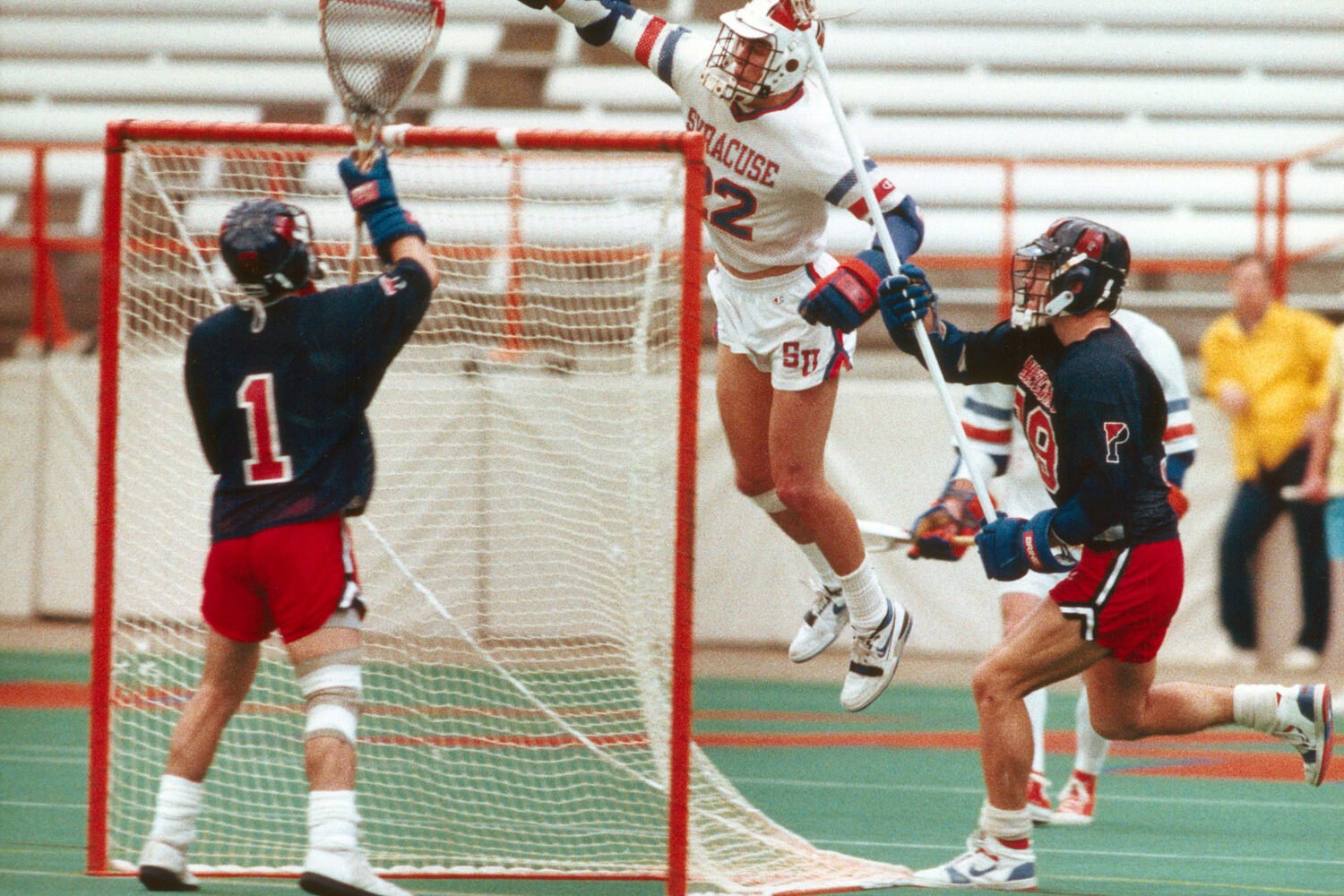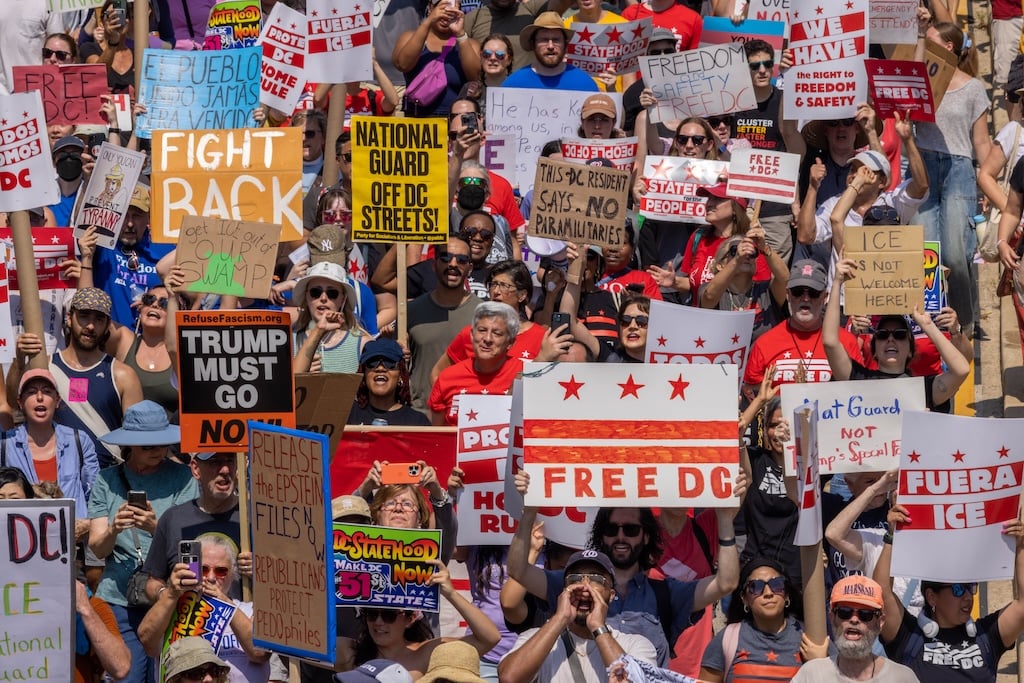Gilbert Arenas doesn’t remember the day when his father came to get him. “I was only three,” he says.
Gilbert was born in Florida, where his great-grandfather had come a century earlier from Cuba. His father was a college student in Miami, his mother a teenager. They weren’t married, and when their relationship soured, his mother left with baby Gilbert in her arms. He was six months old.
His father, Gilbert Arenas Sr., lost track of his son. Two years after he graduated from college, he was jolted by a phone call from his girlfriend’s mother. She’d been caring for young Gilbert in Miami because his mother was in trouble. “Come and take custody of the child,” Gilbert’s grandmother said.
Gilbert Sr. drove to Miami, grabbed his three-year-old son, and headed home to Tampa.
“I never turned back,” his father said. “Ever since, it’s just been the two of us.”
Gilbert would see his mother only once more—when he returned to Miami, at age 20, as a basketball player.
Arenas lived in Tampa with his father and his grandparents. But his father wanted to be an actor. When Gilbert was seven, he and his dad, along with his dad’s girlfriend, piled into a car and took off for Los Angeles. In Texas, the girlfriend bailed out. In the Arizona desert, Gilbert Sr., nearly broke, almost turned around and drove back to Florida. “My manhood kicked in, and I said, ‘Keep going,’ ” he recalls. In California, he made a beeline for Burbank, where he’d been told he could find work as an actor. He had $25 in his pocket and no place to stay.
“We were car people,” the younger Arenas says. The first night they slept in their Mazda at a park—Gilbert in the back seat, his father in front—until police told them to leave. They moved to a drugstore parking lot. The next night they parked in Hollywood. Arenas Sr. tried to rent an apartment but could pay only $15. He and his son were sent packing.
“Dad,” Gilbert asked, “is everything going to be all right?”
They spent a few more nights in the car. At a YMCA, they were turned away, but only after a sympathetic young woman gave young Gilbert $25. They went to another YMCA and were told it was adults only. But a clerk let them sleep on mattresses in the Y’s auditorium. “That was good enough,” Arenas Sr. says. “It was a blessing.”
Better yet, a man noticed son Gilbert dribbling a basketball. “Do you play?” the man asked. “A little,” Gilbert said.
The man liked basketball and after some chitchat offered Arenas Sr. a job—as a clerk at his company. The job led to a loan that paid for rent on an apartment in Van Nuys, a suburb just over the Hollywood Hills in the San Fernando Valley.
Basketball, in an odd way, had deposited Gilbert Arenas in Van Nuys in a stable environment and in a home with a parent dedicated to nurturing his natural skills. Once he took up basketball seriously at 12, he was on his way to becoming one of America’s best players and the leader of the Washington Wizards.
Now, at 24, he is a superstar, though he lacks the usual celebrity trimmings. Arenas’s only endorsement is a basketball shoe Adidas has named after him.
Antawn Jamison, his Wizards teammate, believes Arenas is in the fourth and final stage of a successful career as a pro basketball player. The first was to show he could play at the highest level and had been undervalued as a second-round pick in the 2001 NBA draft. The second was to get money, which he achieved in 2003 with his six-year Wizards contract at nearly $11 million a season. The third was to become an NBA all-star. He’s done that twice—in 2005 and 2006. The fourth is the toughest: carry the Wizards to a championship.
Some in basketball doubt Arenas can do it. The rap is that Arenas is too young and irresponsible to establish himself as a strong leader, and besides, the Wizards aren’t a championship-quality team.
But he has always faced doubters and proved them wrong. It’s the thread that runs through his life. When he decided to attend the University of Arizona, most thought he’d never get in a game for the powerful Wildcats. He took the number zero—the same as his Wizards number today—to symbolize the skepticism he wanted to prove wrong.
As a freshman at Arizona, he started. Leaving college after two years, Arenas was a mystery to pro scouts who didn’t know whether he was a point guard or a shooting guard. He slipped to the 31st pick. The first pick that year—made by Michael Jordan and the Wizards—was high-schooler Kwame Brown. It turned out to be one of the worst selections in NBA history.
By his second year with the Golden State Warriors, Arenas was named the league’s most improved player. Brown was sulking on the Wizards bench. When Wizards general manager Ernie Grunfeld signed Arenas for $65 million in 2003, he took a risk. Wally Walker, general manager of the Seattle Supersonics, was among the doubters. Walker admired Arenas’s talent but said he didn’t expect him to be “a 28-points-a-game scorer.” Last season, Arenas averaged just over 29 points a game.
Arenas came to Washington with the goal of making the Wizards his team and Washington his town. He began to emerge as the team’s leader in his second season. After the Wizards won their first playoff series over the Chicago Bulls in 2005, his teammates waited in the locker room for Arenas before celebrating. He was being interviewed on TV. Arenas burst into the locker room and shouted, “We’re going to the beach, we’re going to the beach, we’re going to the beach.” Their next playoff foe was the Miami Heat, which swept the series.
Arenas is “the cornerstone of the franchise,” says coach Eddie Jordan. “I’ll be riding his coattails.”
Yet Arenas has a reputation. He likes to play jokes on teammates and has unusual habits like playing video games at halftime.
When he arrived at the University of Arizona, coach Lute Olsen said he was “17 going on 12.” Olsen thought Arenas wasn’t ready for the NBA lifestyle and urged him to stay a third year in college. Arenas left Arizona for the NBA in 2000. After watching Arenas’s progress, Olsen has changed his mind. He visited Arenas in Washington last year and says the city and the team were “perfect” for Arenas.
“When you’re the best player on the team, you lead the team,” says Wizards assistant coach Mike O’Koren. In each of his three seasons here, Arenas has sought to lead by example, improving in an aspect of the game.
Last year, it was midrange shooting. For the 2006–07 season that begins November 1, O’Koren says Arenas is being asked “to become a better defender” and “a better leader.” Theory is the team will respond to his cues.
The collective wisdom of the coaches—Eddie Jordan, Mike O’Koren, Tom Young—is that Arenas is ready to take charge. With two new players—forward Darius Songaila and defensive specialist DeShawn Stevenson—and the return of swingman Jarvis Hayes, the Wizards shouldn’t miss Jared Jeffries, who jumped to the New York Knicks this past summer. The team has a solid chance to improve on last season’s 42–40 record.
But a lot, perhaps everything, depends on Arenas. “Our competitors are getting better,” Arenas tells me. “We’ve got to get better.”
His arrival in 2003 was “the most significant thing for the team since the Elvin Hayes trade in 1972,” says agent Dan Tobin, referring to the player who, along with Wes Unseld and Bobby Dandridge, led the team to its only NBA championship in 1978.
“One guy—Gil—became the fulcrum event,” says Ed Tapscott, the ex-president of the Charlotte Bobcats and former basketball coach at American University. “Talk about paradigm shifts. That’s what it was. That changed the perception of the team throughout the league.”
Now, with a team of young veterans and one superstar, they have an opportunity to develop into a champion.
Arenas is an antidote to the self-centered superstar stereotype. He shuns the spotlight. He has no bodyguards. He doesn’t collect groupies. And he talks to his father often. Once a UPS employee, Arenas Sr. now writes TV commercials with his son’s help.
One of the reasons Arenas left Los Angeles was to avoid distractions. “I looked at players who stayed at home,” he said. “It’s hard. You have so many people grabbing on you.”
He doesn’t drink or smoke. He has four tattoos, but isn’t flamboyant. The fourth tattoo, a recent addition, has the name, date of birth, height, and weight of his daughter, Amay Semaya Arenas, born last December. During two lengthy interviews, Arenas didn’t mention he has a daughter, a fact only recently made public through the Wizards media guide. In answering questions about his personal life, he says only that he doesn’t have a girlfriend and his social schedule revolves around gathering friends to play video games. His favorite is Halo, not a tame game. He came close to buying a home once rented by Deion Sanders, the flashy defensive back who played briefly for the Redskins. Instead, Arenas bought a large red brick house in Great Falls, Virginia, built along traditional lines. He rarely eats out. “I’m just a house person,” he says. At home, a cook brings food every few days. On the road, he orders the same thing from room service: a hamburger with provolone cheese, French fries, a Coke, and ice cream. It never varies.
He is approachable. Waiting for his luggage at LaGuardia Airport in New York, Arenas was recognized by a woman and her young son. He chatted with them before grabbing his bag. Then he went back to say he’d enjoyed meeting them.
For exercise, Arenas and Wizards trainer Andrew Cleary ride bikes from DC’s Verizon Center through Rock Creek Park to Chevy Chase and Silver Spring, then return down 16th Street. “Coming back through the city is the fun part,” Arenas says. He wears a baseball cap, sunglasses, and earphones but is hardly incognito. People in cars spot him and honk. He often stops to sign autographs.
“Gilbert is very considerate and caring,” Grunfeld says. How often do you hear that about a sports superstar? When the Wizards assistant trainer got married, Arenas paid for his honeymoon. In 2002 while with the Golden State Warriors, he read a newspaper story about a DC boy, Andre McAllister, whose father was in jail and whose mother died in a fire. Arenas took McAllister, now 12, under his wing after he joined the Wizards. He spends time with McAllister and buys him clothes and school supplies.
Arenas believes role models matter. He aims to exemplify this lesson: “With hard work and dedication to my craft, anything can happen.”
For all the talk about his lack of maturity, Arenas is careful about whom he’s close to and how he spends his money. He has five cars—a Lamborghini, Ferrari, Escalade, and ’63 and ’64 Chevy Impalas (he calls them “California cars”). But with his salary he hasn’t splurged as much as many players. A few years ago, he asked the NBA’s smallest player, Earl Boykins, how many cars he had. “None,” Boykins said. Boykins explained that models change every year and it was smarter to lease cars. So Arenas leases his three luxury cars.
He has a theory about investing: It’s risky to be financially rich and real-estate poor or financially poor and real-estate rich. “You want to be even,” he says. He owns his Great Falls home and a condo in Miami Beach worth roughly $1.5 million. He bought seven acres in Vienna that he might build a new home on. He bought another condo in the W Hotel in Las Vegas. “I’ll rent it to the high rollers,” Arenas says. He had a chance to invest with ex-Wizard Christian Laettner in condos in Durham, North Carolina. He declined but now regrets his decision. Laettner made millions on the deal.
Arenas is further distinguished from other superstars by Gilbertology, his quirky streak. Arenas decided to adopt a routine before shooting free throws—three loops of the ball around his waist followed by three dribbles—after he’d done the routine without thinking about it, then spotted kids imitating him.
His most famous antic is to throw his jersey into the crowd after each game, home or away, win or lose. He pays for the jerseys at $250 a pop.
He has a collection of about 500 basketball jerseys. He has the one worn by Wilt Chamberlain when he scored 100 points in a game. And he has Chicago Bulls jerseys in three colors worn by Michael Jordan in 1984. He was eager to buy a “Pistol Pete” Maravich jersey but balked at the $100,000 price tag. At a game with the Utah Jazz, he asked Greg Ostertag, a journeyman center, for a jersey. The team’s trainer was surprised: “How many jerseys must someone have to come out and ask for a jersey from Greg Ostertag?”
A consumer of pop culture, Arenas has a collection of 3,000 movies and likes to watch TV. His favorite show is 24.
Arenas has one other addiction: working out. He works out for eight or nine hours every day. “When I say every day, it’s not Monday through Friday,” says Wizards trainer Andrew Cleary. “It’s from Sunday through Sunday. There’s no weekends with him.” In the morning, Arenas shoots in the practice gym at the Verizon Center and lifts weights or rides a stationary bike. He comes back in the afternoon to shoot, and again in the evening. “With Gil, it’s every night,” Cleary says.
During the playoffs in Cleveland last spring, Arenas asked Cleary to find a gym for him to practice shooting. It was midnight. Cleary couldn’t locate an open gym.
Now he’s altering his lifestyle by spending time in the thin air of simulated high elevations. He’s having his house outfitted to lighten the air pressure inside, and a tent he can take on the road will produce the same effect. The point is to acclimate his body to lower oxygen levels to keep him from getting tired and out of breath late in games.
Arenas has 9 percent body fat. Cleary and Wizards coaches worry that he works out too much and rests too little. He sleeps three or four hours a night. “I play basketball year-round,” Arenas says. “After the season, I keep going.”
Arenas cried when he wasn’t taken in the first round of the NBA draft in 2001. He was 19. He had worked out with several teams and figured he’d be one of the seven lottery picks. The Boston Celtics had three first-round picks, and Arenas was certain he’d be one of them. But the Celtics passed on him. Arenas found out later that the Celtics thought he was a quitter because he left their camp after injuring his Achilles tendon. The Portland Trail Blazers had also shown strong interest. They chose Zach Randolph of Michigan State as the 19th pick. Word got back to Arenas that the Trail Blazers thought he couldn’t shoot. Arenas told his father, who was throwing a draft party for his son, that he must be going to Sacramento. The Kings chose Gerald Wallace of Alabama with the 25th selection. “I started crying,” Arenas says. He left the party.
Golden State chose him with the second pick of the second round. “At first, I didn’t know where Golden State was,” he says of the team that plays in Oakland across the bay from San Francisco.
The problem was Arenas’s size and lack of experience. He’s a fraction under six-foot-three in his bare feet, not big enough to play shooting guard in the NBA. He’d be dominated by bigger players like Kobe Bryant. Arenas wanted to be a point guard, but he’d played that position only sporadically at Arizona. “No one was quite sure what his position was,” says Wally Walker. “It turned out he didn’t need a position. He’s just a guard. We missed on him, based on what we know now.”
Arenas plays with a chip on his shoulder and thrives on proving his critics wrong. Based on whether he makes a shot or not, he assumes he’s either hot or overdue to score. At Arizona, he announced he’d be a starter by midseason. He was. He said the same thing about Golden State. But Warriors coach Dave Cowens, the former Celtics star, left him on the bench. Arenas resented the lack of playing time. Just past midseason, point guard Larry Hughes was injured, and the new Golden State coach, Eric Musselman, replaced him with Arenas. Hughes and Arenas would later play together for two years with the Wizards. Cowens now coaches in the women’s pro league.
At Golden State, Arenas and Dan Fegan, his agent, were determined to solidify Arenas’s role as a point guard. Musselman also saw Arenas as a point guard. “We thought he had the ball-handling skills and the mentality to play the hardest position in the NBA,” Musselman, who now coaches the Sacramento Kings, tells me. “I loved coaching him because he’s easily motivated. He’s always seeking a challenge. He takes his game to a higher level. The best is yet to come.” Arenas and Musselman remain close friends.
Eddie Jordan wasn’t so sure about Arenas. Watching him at Golden State, Jordan had this impression: “He goes too fast. He’s always losing the basketball. He doesn’t look to help his teammates. This kid is an athlete, not a basketball player.” According to Jordan, a point guard must first set up the offense; second, pass; and only third, shoot. When Arenas joined the Wizards, Jordan thought he had the three obligations of a point guard backward.
Some of Arenas’s teammates thought so too. Wizards center Brendan Haywood says Arenas was “known as a loose cannon.” As point guard, “he has a responsibility to his teammates to get everybody involved,” Haywood says. “At first he struggled with that. He tried to score all the time. He was launching from everywhere his first year.”
That has changed. “His progress has been phenomenal,” Grunfeld says. “He’s a modern-day point guard. If you look around the league, point guards are bigger scorers.”
Now he makes his teammates play better. “Everybody who plays alongside him has career years,” swingman Caron Butler says. “Look at Larry Hughes. He has a career year playing with Gilbert.” Antawn Jamison was selected for the all-star team. Butler had about the same amount of playing time with the Wizards last season as he did with the Los Angeles Lakers the year before. With the Wizards, Butler improved in every category.
Arenas has three physical skills: quickness, strength, and endurance. He has the quickest first step in basketball. He explodes past any defender. The Sonics’ Walker says he first noticed this in Arenas’s second year at Golden State. Gary Payton, an eight-year defensive all-pro, was told to cover Arenas. “Payton couldn’t stay in front of him,” Walker says. “Arenas has gotten to the point where he can’t be stopped. He can get anywhere he wants to with the ball.”
This leads to an Arenas habit that drives his coaches batty: He always wants to take the last shot in a close game. Knowing he can get around any defender, he waits at the top of the key, outside the three-point line, until the last second to make his move. “Gilbert takes that to the extreme,” assistant coach O’Koren says. “He wants the ball to go in when the red light goes on.” In the fifth 2005 playoff game against the Bulls, Arenas lingered until time had nearly expired. His game-winning shot over seven-foot-one Tyson Chandler left his hand with 0.3 seconds on the clock. The coaches were frantic. “I didn’t think he was going to get the shot off,” O’Koren says.
The shot itself? “It was a thing of beauty,” he says.
His strength allows Arenas to overpower other point guards and drive to the basket, even as he’s pummeled by bigger players. He is a strong finisher. Most of the time he either makes the shot or gets fouled. Jordan says he taught Arenas to go straight to the basket and not rely on fakes. “I call him a straight-line assassin,” Jordan says. Arenas also has a big wingspan: His is six-foot-nine, six inches more than his height.
His fearlessness in driving to the basket means that Arenas is willing to take hits. His coaches and teammates—the entire NBA—have been surprised at his ability to get up after being banged to the floor. “He gets his butt knocked hard to the floor, and he never backs off,” Tom Young says. “He’s a strong physical player.”
Physical skills alone don’t make a great player. It’s what you do with them, how hard you work, your attitude, your will to win that lift you to greatness. Arenas wants to be the world’s best basketball player. And he wants to prove every doubter wrong. At Arizona he played his best games against West Coast schools that didn’t recruit him. Last winter, he blew away the Knicks in their first meeting with the Wizards after the NBA all-star game. He scored 15 points in the first six minutes. Players on the Wizards bench laughed and shouted in unison, “Should have voted for him, Larry.” Knicks coach Larry Brown hadn’t voted for Arenas for the all-star team. It was, Arenas says, his “vendetta game.”
When Arenas transferred to Grant High School in Van Nuys in the tenth grade, he signed up for the basketball team and was assigned to the junior varsity. Ten minutes into the first practice, he was pulled aside by the varsity coach, Howard Levine. “You’re going to make it,” he said to Arenas. “Make what?” Arenas asked. “You’ve got a chance to be an NBA basketball player,” Levine said.
For the first time, Arenas became a star. “Gilbert needed a lot of developing, but we were going to give him the ball,” Levine says. The coach stuck with this plan even when two older players quit the team because Arenas had taken the top spot. In his junior year, Grant won the league title, and Arenas averaged almost 30 points a game.
Arenas was a disciplined player. His father, a good athlete and a coach of youth-league teams, had instilled in Arenas a work ethic and a hatred of losing. He told his son not to waste time: While he’s resting, rival players are practicing. His father says, “I didn’t want him to be lazy about his day.”
In his senior year, he averaged 33 points a game and made the LA all-city team for the third straight year.
He was not a trouble-free student. Levine says he was sometimes “obnoxious in class,” got in fights, and had moody spells. “But he always had that good heart and that good nature. And he always made the right decisions.” If he needed to study more, he would. If he needed to show more respect for authority, he would. “He found his solace and his soul” on the basketball court, Levine says. “All the great ones do. When you need to find yourself and get back to ground zero, you find a gym and start shooting.” Arenas still follows that advice.
Levine was the first to insist Arenas play point guard. That, the coach said, would be his ticket to the NBA. “You’re just a point guard who can shoot,” he told Arenas.
Arenas came out of high school as a confident player, but he was knocked down a peg when only a handful of major colleges recruited him. UCLA told him it had only one open spot and wanted to save it for Carlos Boozer, who wound up going to Duke. On a tip, he came to the attention of an Arizona assistant, Rodney Tention. After visiting the campus, Arenas told his dad, “I loved Arizona. I had a good time. I want to get there.” His father leaned toward Kansas State, where a friend was an assistant coach and promised Arenas at least 1,000 minutes of playing time, but his son prevailed.
It was at Arizona that Arenas became a gym rat. A student manager was assigned to each basketball player. Arenas wore his manager out by calling on him day and night to join him for workouts. The manager had to ask for relief.
It was also at Arizona where Arenas felt the pain of losing a big game. Arenas had hurt his arm and could barely lift it above his shoulder, but he played anyway against Duke in the NCAA championship. Arenas went 4 for 17 from the floor and missed all four of his three-point attempts. Duke won. “We still feel disappointed in what happened,” Arenas said. Olson is more blunt: “If Arenas had been at full strength, we felt we would have won.”
Though the NBA draft was a nightmare for Arenas, it turned out to be a financial bonanza. First-round draft picks sign four-year contracts at the rookie pay level. As a second-rounder, Arenas wasn’t covered by this rule. His agent, Dan Fegan, negotiated a two-year deal with Golden State. It meant Arenas would be a free agent in 2003, two years ahead of first-rounders such as Tony Parker and Kwame Brown. Fegan was gambling that Arenas would be a hot property after two years in the NBA. “I had a lot of confidence in Gilbert,” Fegan says. “He was prepared to take a chance because he believed in himself.” Arenas fired Fegan as his agent in September without offering a public explanation.
It paid off so handsomely—$65 million over six years—that what became known as the “Arenas rule” allowing second-round picks to freely negotiate a contract was revoked by the NBA. But the NBA made Arenas a rich man at 21 and eased the pain of not being a first-round draft choice.âž
The deal that brought Arenas to Washington almost fell through. Fegan wanted $2 million a year more than Grunfeld and the Wizards were offering. Grunfeld asked his friend Ed Tapscott, the ex-Bobcats boss, what to do. Pay it, Tapscott said. Grunfeld agreed. If he hadn’t, Fegan says, Arenas probably would have gone to the Los Angeles Clippers. And the Wizards probably would still be a failing franchise.
Even today Arenas doesn’t know his way around town very well. When he and his trainer rode bikes to Mount Vernon, they got lost and had to ask directions back to the Verizon Center. When they rode to Mount Vernon a second time, they got lost again.
Though Arenas has lived here three years, he hasn’t visited many of the historic sites. He hasn’t toured the White House or the Capitol or the museums on the Mall. But he was thrilled to ride on the same shuttle to New York as First Lady Laura Bush.
What does he like about Washington? “My thing is all four seasons,” he says. LA has only one season. What else? “You get stuck in traffic because the President is coming by,” Arenas says. “That’s fun.”
Arenas has goals. He wants to be in the NBA Hall of Fame. He wants to win an Olympic gold medal. This is possible in 2008 if Arenas is able to work himself back on the team that cut him before the World Championship in August. His most urgent goal is to win an NBA championship—the culmination of Antawn Jamison’s stages in Arenas’s emergence as a true superstar. That’s one of the reasons he came to Washington.
Arenas hopes to build a championship team around him. He’s already said he’ll defer some of his money to allow the Wizards to sign fresh talent. He says he doesn’t want to be like Kevin Garnett of the Minnesota Timberwolves or Ray Allen of the Seattle Supersonics. They make so much money that their teams can’t afford good new players. Arenas isn’t committed to staying in Washington to play on a marginal playoff team.
His contract runs out in three years, but he has an opt-out clause in two years. That means he could leave in 2008. He’d rather not. He bought those seven acres in Vienna in the hope that he’d sign a second contract with the Wizards. If it happens, he’ll start building a new home on the lot. So basketball fans might keep an eye on that property. If workers begin clearing trees, that’s good news. It means the Wizards may be headed for a championship.
Games That Made Zero a Hero
Gilbert Arenas characterizes his three years with the Washington Wizards as “making strides, getting better, taking steps, climbing the ladder. That’s the story of my career.” He’s also had many big games. Here are his five greatest:
1. May 4, 2005. Arenas sinks The Shot, a buzzer-beating jumper for a 112–110 victory over the Chicago Bulls that paved the way for the Wizards to win their first seven-game playoff series since 1979.
2. November 5, 2003. Asked about his fourth game as a Wizard, Arenas offered two words: “Triple double.” He had 25 points, 12 rebounds, and 10 assists while beating the Dallas Mavericks.
3. November 12, 2005. “A great percentage,” Arenas said in reliving this 110–95 win over San Antonio. He was 15 of 20 from the floor, scoring 43 points.
4. December 20, 2004. Arenas drove the lane, double-clutched, and hit a layup with 0.8 seconds left to beat the Golden State Warriors, 103–101, in his first game against his old team.
5. February 25, 2006. The “vendetta game.” Arenas scored 46 points to punish New York Knicks coach Larry Brown for keeping him off the all-star team (he later replaced an injured player). Arenas scored 23 points in the first quarter. Wizards 110, Knicks 89.
—–
Fred Barnes is executive editor of the Weekly Standard and a Fox News commentator. He is author of Rebel-in-Chief, released recently in paperback by Crown Forum.


